
~~~~~~~~~~~~~~~~~~~~~~~~~~~~~~~~~~~~~~~~~~~
Live Earth Farm (Com)Post
3rd Harvest Week, Season 13
April 21st - 27th, 2008
~~~~~~~~~~~~~~~~~~~~~~~~~~~~~~~~~~~~~~~~~~~
In this issue
--Greetings from Farmer Tom
--The Checklist...
--Strawberry Etiquette
--Good News on Food Prices
--The Bread Share
--Be SAFE!!
--Pictures around the farm
--What's in the box this week
--Notes from Debbie's Kitchen
--Calendar of Events
--Contact Information
" Without human intervention the processes of nature
have evolved self-regulating forces of beauty, grace and efficiency.
Our challenge is to learn how to honor them and be inspired by their
truth to create new cultural values and systems. "
~
James and Roberta Swan, from 'Bound to the Earth'
Greetings from Farmer Tom
~~~~~~~~~~~~~~~~~~~~~~~~~~~~~~~~~~~~~~~~~~~~~~~~
In our modern use of the English language we describe farming as an
"industry", where food is not grown but "manufactured" like computers
or cars. Food is produced on “factory
farms”, conveniently packaged, then shipped to stores where consumers
can simply pick it up off the shelf. The Pajaro Valley area around
Watsonville is a typical example of factory farming when it comes to
strawberries and raspberries. I watch with amazement how the industrial
principles of mechanization are applied to a living biological system,
controlling every step of the process from seed to shelf. Sometimes
I envy such predictability and control, especially when here on our
Farm I feel caught in a chaotic web of constant change and unpredictability. To
make my point, I only have to reflect on what I thought would be a
calm Sunday alone with the kids while my wife Constance is away for
the week.
When temperatures climbed over 80 degrees last weekend I was certain that I had
timed the planting of our heat loving peppers, tomatoes and eggplant just perfectly.
I was starting to believe that I was ahead of the game, or at least on schedule,
with green beans already germinating and summer squash pushing new vigorous leaves.
But this reassuring feeling was short lived. 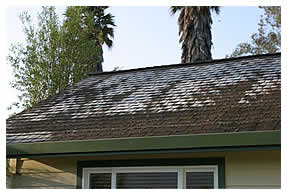 I
stepped out Sunday morning and there was frost on the roof. I could see my breath
and hear the grass crunch under my feet. I was shocked and then slightly panicked,
thinking about the vulnerable young seedlings I had recently planted. It's the
first time we have ever had frost this late in April.
I
stepped out Sunday morning and there was frost on the roof. I could see my breath
and hear the grass crunch under my feet. I was shocked and then slightly panicked,
thinking about the vulnerable young seedlings I had recently planted. It's the
first time we have ever had frost this late in April.
As I walked out to check on the state of our summer squash, I saw a gopher pull
an entire lettuce plant down its hole. Gophers have been voracious this spring;
it’s one thing to share a lettuce plant with the wildlife, but my pacifist
nature was stretched last week when I watched an entire young apple tree being
knocked down by these "underworldlers". But I took a deep breath
and kept walking, thinking a gopher has the right to eat as well. I was relieved
to see that the row covers (large blankets of breathable light fabric) had kept
the squash plants protected... well, mostly. There were places where the wind
had blown the blankets off. As I walked through a patch of fava beans, I noticed
the aphid population has exploded. Typically I am not worried, but this year
the ladybugs and soldier beetles have not been able to keep pace. I look over
to the plum trees, concerned that possibly the aphids had established themselves
there with the same kind of vigor. But at closer inspection I am relieved to
see that the ladybugs we released recently were already well established and
had been reproducing (ladybugs in the larval stage are much more effective in
eating aphids).
My biggest and most immediate worry, however, was the peppers and eggplants which
we just planted a couple days ago. I am hoping I can do something to protect
them from dying, which is likely if I don't protect them from another frosty
night. Unlike green beans which we sow every ten days, these popular nightshades
are started in the greenhouse in February and only planted once. Luckily
all our tomatoes are safely tucked away in the greenhouse; they were not scheduled
to be planted until this week.
As soon as I got back from my walk, I called some of my farmer friends to see
if I could get some more row cover from them, since most of ours are already
deployed protecting the green beans and squash. I will have to risk losing our
first green bean planting (by ‘borrowing’ its row cover for the new
plants) if I can't find more row covers by the end of the day. At 5pm Sunday
I get a call from a Billy Peixote who has some leftover row covers in a field
on the other side of town. I take the truck, head out and, not paying close attention
as I drive into the field (the road slopes uphill), the truck slips away on a
muddy patch leaving me stuck. If breathing helps to calm oneself down, the day’s
events provided an excellent opportunity to practice! I kept breathing for the
next 3 hours while we got the truck pulled out, and the row cover blankets spread
over most of our 2 acres of peppers and eggplants even though strong gusts of
wind continually tried to blow them off.
By the time we finally we got most of the seedlings tucked away under their new
blanket, the sun was down and I could tell it was going to be another cold night.
A small reward was in store for me though, as I walked over to pluck a sweet
strawberry from the patch on the other side of the pepper field. A quick
inspection of the underside of the strawberry leaves reassures me that the Red
Spider Mites (also known as Persimillis) we’d recently released have kept
their more damaging Two-spotted Spider Mite cousins in check. I pick a basket
of red ripe berries and took them home with me, looking forward to indulging
with the kids in one of our favorite desserts: berries dipped in whipping cream.
One thing in life is certain: everything changes. How tolerant we are to change
seems directly linked to our instincts, and our hardwired sense of survival.
Here on the farm, the unpredictable nature of things is part and parcel for a
land as alive and diverse this place is. Rather than removing myself and
trying to control every situation, I make an attempt to fold myself in with the
rest, apply as much mindfulness and knowledge as I can, and integrate
as much as I am capable of from others who also participate in this rich, interwoven
relationship.
- Tom
<back to top>
The Checklist...
~~~~~~~~~~~~~~~~~~~~~~~~~~~~~~~~~~~~~~~~~~~~~~~~
The checklist in the binder at your pickup
site is a very important tool, but it is more-or-less a one-way communication
tool:
We use it to communicate to you...
We use it to tell you exactly what we have dropped off for you (and the
other members) at your pickup location each week. The key word here is ‘exactly’...
if you take the wrong thing, you are directly impacting someone else at your
location. Remember, we are all in this food web together. So please, take the
time to read next to your name *each week* to verify what you are supposed to
take. Pay special attention if you see what look like handwritten changes to
quantities.
Last week, for example, we had several instances of people taking more strawberries
than they were supposed to, leaving the folks who pick up later in the day shorted.
The lists on Wednesday had been printed out with “2 baskets” per
family share and “1” per small share, but then with the cold snap,
strawberry production had dropped, so Tom had to reduce the Family share berries
to only 1 basket. Since the reports had already been printed, he went through
by hand, the morning of delivery, and crossed out every “2” and replaced
it with a “1.” I guess not everyone caught this change.
But please don’t use it to communicate to us...
This is kind of hard to explain, but please – DON’T write
important messages for us on the checklist. The list stays at your pickup
site and is only collected and brought back the following week when the new shares
are dropped off. And since they don’t make it back to the office until
the end of the day, I don’t see them until the following day or if I get
busy, the following week.
So by the time I see your note and can do anything about it, it may be three
weeks from the date of your original note! Thank-yous and feedback are fine,
but if there are any issues at your pickup location that require a timely response,
please call or email me at the farm and I can take care of you much sooner.
- Debbie
<back to top>
Strawberry Etiquette
~~~~~~~~~~~~~~~~~~~~~~~~~~~~~~~~~~~~~~~~~~~~~~~~
In addition to the ‘please-only-take-what’s-next-to-your-name-on-the-checklist’ plea,
above, I have two more requests:
1. Do not go through and hand-pick berries from amongst multiple baskets in order
to assemble your own basket of berries. This is a community, and we want everyone
who picks up to get their fair share. So please... put yourself
in the shoes of the last person who will be picking up that day: be thoughtful,
and just take the basketfuls as they are assembled.
2. In a similar vein, please do not allow your children to help themselves to
berries from the flats. This is a good opportunity to teach them patience and
self-control. Make sure they wait, and only eat from the baskets you have selected
to take home with you.
Thank you!
<back to top>
Good News on Food Prices
~~~~~~~~~~~~~~~~~~~~~~~~~~~~~~~~~~~~~~~~~~~~~~~~
An alert CSA member sent me this great article in a recent New York Times about
the silver lining, if you will, to the cloud of higher food prices. In essence,
it is the cost of conventional foods which is climbing, because they are
the ones that rely so heavily on petroleum for fertilizers, pesticides, processing,
packaging and shipping. So we may very well see a leveling of the playing field,
and (hopefully!) more farmers going into organic production... to save money!
Won’t that
be a nice change from the conventional ag subsidies of today’s market?
If you’re interested please click
here to read the article.
<back to top>
The Bread Share
~~~~~~~~~~~~~~~~~~~~~~~~~~~~~~~~~~~~~~~~~~~~~~~~
We still have bread shares left! The bread share doesn’t start until two
weeks from now (May 7th/8th) so if you somehow missed hearing about it and haven’t
signed up for this yet, you still have time! If you are a bread lover, you won’t
want to miss this!
Click here to read more about the bread share.
Email me (Debbie) at the farm farmers@cruzio.com if you want to sign up! I’ll
send you payment instructions (we have an easy paypal page, or you can send us
a check).
<back to top>
Be SAFE!!
~~~~~~~~~~~~~~~~~~~~~~~~~~~~~~~~~~~~~~~~~~~~~~~~
Spotted at a pickup site (location name withheld): a member parks their car on
a busy street, at dusk, leaves driver door open into the traffic (cars must cross
double-yellow line to avoid hitting it), leaves child unattended in car, and
dashes across street to get their CSA share... PLEASE, do not do things like
this! Your safety, your child's safety, and the safety of others around you are
WAY more important than the minute you may have saved doing this.

<back to top>
Pictures around the farm
~~~~~~~~~~~~~~~~~~~~~~~~~~~~~~~~~~~~~~~~~~~~~~~~
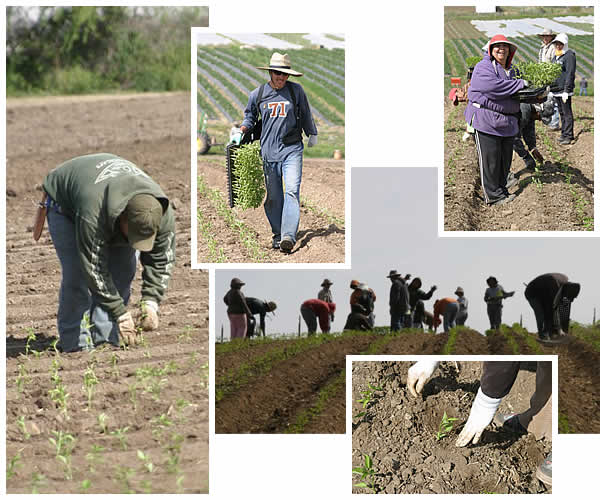
Here's the whole crew out planting peppers.
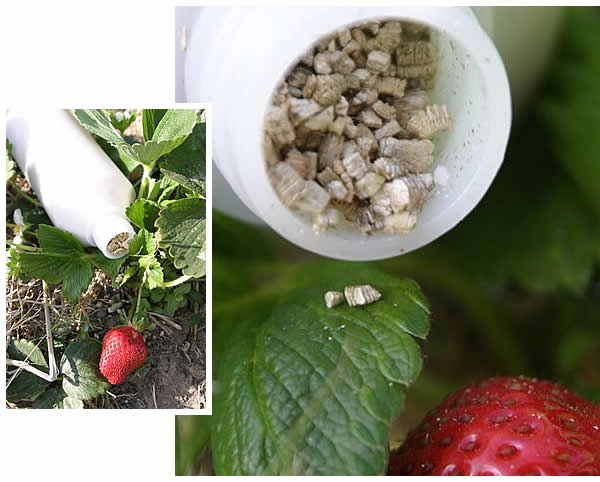 The
microscopic Persimillis (the little specks in the neck of the bottle
and on the strawberry, not the vermiculite, which is just a medium for
transporting the insects) are scattered over the strawberry plants to
combat the damaging two-spotted spider mite.
The
microscopic Persimillis (the little specks in the neck of the bottle
and on the strawberry, not the vermiculite, which is just a medium for
transporting the insects) are scattered over the strawberry plants to
combat the damaging two-spotted spider mite.
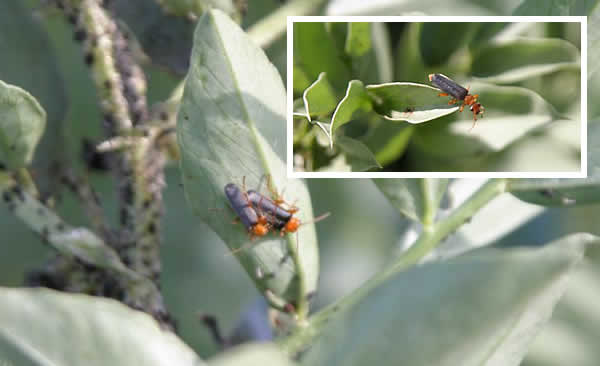
Soldier
beetles on the fava plants (note aphids in background).
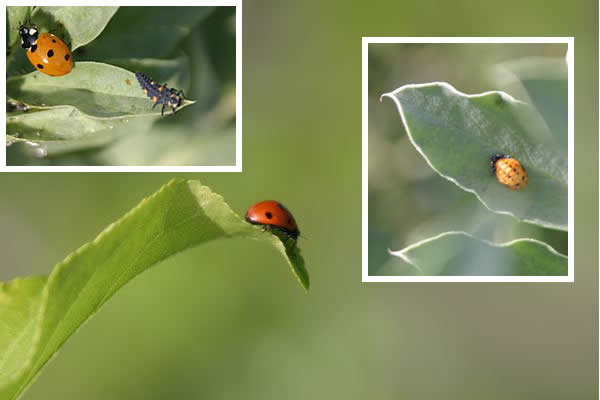
Everybody's favorite beneficial insect: ladybugs. Note the two different
(and far less familiar) larval stages of the ladybug: the mostly black
one in inset above left, and another, inset right.
What's in the box this week
~~~~~~~~~~~~~~~~~~~~~~~~~~~~~~~~~~~~~~~~~~~~~~~~
Content differences between Family and Small
Shares are in red; items
with a “+” in
Family Shares are more in quantity than in Small; anticipated quantities, if
any, are in parentheses, as are the source of any produce if not from Live Earth
Farm (LEF). Occasionally
content will differ from this list (typically we will make a substitution),
but we do our best to give you an accurate projection.
Family Share:
White beets, topped and bagged (the last of the
crop)
Broccoli (Lakeside) +
Chard
Fava
Beans +
Fennel (LEF or Lakeside) +
Green garlic
Red Russian Kale, bagged or bunched +
Lettuce +
Onions +
Radishes
Strawberries (2 baskets)
Small Share:
Broccoli (Lakeside)
Chard
Fava
Beans
Fennel (LEF
or Lakeside)
Green
garlic
Red Russian Kale,
bagged or bunched
Lettuce
Onions
Radishes
Strawberries (1 basket)
Extra Fruit Option:
(doesn't start until May)
<back to top>
Notes from Debbie's Kitchen
~~~~~~~~~~~~~~~~~~~~~~~~~~~~~~~~~~~~~~~~~~~~~~~~
Click
here to go to recipe database
Hello everyone! Member Seth Silverstein sent me a
very good suggestion, and I have taken it. You may notice in the “What’s in the Box” list,
above, that now each veggie is also a live link (hyper-link). I have linked them
each to their corresponding section in the recipe database! Keep in mind that
the recipes below will also be there, but they will appear at the end of their
respective list.
Oh, and before I forget, if you’re new to Live Earth Farm and "Debbie's
Kitchen", the square bracketed [] comments interjected in other peoples’ recipes
are my own two cents. - Debbie
What’s new this week? Fennel! Delicate licoricey flavor and fragrance,
and a crisp, celery-like texture, fennel is one of my favorite veggies (I know,
I say that about practically every veggie!) ;-) When you get it home, cut the
fluffy-topped stalks off of the bulbs and keep the nicer fronds for garnishes
and such. You can store them in the same bag as the bulb. Remember as always
to add unwanted trimmings to your soup-stock bag in the freezer! (See
Week 1 newsletter discussion on green garlic.)
Remember, the fava beans are still in transition, so you will likely get
a mix of young favas, which you can cook and eat pods and all, and their more
mature counterparts, which you can shuck and use the beans inside. See both Week
1 and Week
2 newsletters for discussions of how to handle both stages.
We will be getting green garlic for several weeks still, and the fun part
is watching the progression from week to week, as the bulbs at the base of the
stalk start to form, and then the cloves themselves start to differentiate. Once
they get fully mature, we’ll stop putting them in your share for awhile;
they’ll all get harvested and laid out in the sun to cure, and then later
in the season, you’ll start seeing something more similar to what you’re
used to getting in the store: a dry bulb with a cluster of cloves separated by
papery skins. But until then, enjoy using the green garlic, stalk and all...
as much of it as you’re willing to wash, chop up, and cook with!
To store the green garlic, when I get home I snip off the green leaves a few
inches from the stalk (otherwise they’re sometimes too unwieldly), wipe
off any moisture with a towel, trim off the roots (but leave the root base attached)
then enclose in a plastic bag and stick in the fridge. When I go to use it, I
then trim off the root base, and cut off each dark green leaf just below where
it attaches to the stalk by running a knife around its circumference and only
cutting off that layer. Remember to check for dirt, but otherwise you can chop
up and use it all... from the bulb to the stalk!
Cooking with Kale and Chard Stems
Member Sumana Reddy emailed me last week with this message:
“Debbie, I don't recall if you've ever mentioned that when the stems are
stripped off of kale or chard, instead of dumping them you can chop them really
fine, and sauté and braise in olive oil with some water to cover after
frying a bit, add lots of pressed garlic and you have a second, entirely different
veggie!”
She makes a good point, in that the stems of these veggies are perfectly edible.
It is all a matter of taste and texture, as well as (I think) whether you need
to stretch your veggies to last the week, or tend to have more than you can eat.
But the important thing to know is that there is no law against eating the stems!
Pasta with Anchovies, Currants, Fennel and Pine Nuts
undated clipping
serves 4
½ C olive oil
8 anchovy fillets
1 lg. onion, very thinly sliced
1 large fresh fennel bulb, trimmed, halved, and very thinly sliced [if the bulbs
you get are small, use two]
¼ tsp. dried crushed red peper
2 small tomatoes, chopped [use canned, or plump up some sundried – don’t
buy fresh tomatoes out of season!]
¼ C pine nuts
¼ C dried currants
¾ lb pasta [they suggest perciatelli or linguine]
¼ tsp. saffron threads
1 C fresh breadcrumbs, toasted
Heat oil in large skillet over medium heat. Add anchovies; mash with back of
a fork. Add onion, fennel, and red pepper. Sauté vegetables until tender,
about 5 minutes. Add tomatoes, pine nuts, and currants. Reduce heat to low and
cook 5 minutes to blend flavors; season with salt and pepper.
Meanwhile, cook pasta in large pot of boiling salted water until tender but still
firm to bite.
Drain pasta, reserving 1 cup cooking liquid. Add saffron to reserved liquid and
stir to dissolve. Return pasta and saffron water to pot. Add tomato mixture;
toss over low heat until sauce coats pasta. Mix in breadcrumbs and transfer to
bowl.
Steamed Carrots with Mint
undated clipping
serves 4
“Carrots are gently infused with a sweet, minty flavor.”
4 large fresh mint sprigs plus 1 tbsp. chopped fresh mint
1 lb carrots, peeled, and if small, left whole [even with a bit of green tops
attached!]. Otherwise, cut them into smallish segments or coins
1 ½ tbsp. butter, room temp.
Fleur de sel [if you have it] or a nice coarse kosher salt or sea salt
Place mint sprigs in bottom of saucepan; place steamer rack in pan. Add just
enough water to touch bottom of steamer rack; place carrots on rack. Cover pan
and steam over high heat until carrots are just tender, 8 to 10 minutes, depending
on size. Transfer carrots to a bowl; toss with butter and chopped mint. Sprinkle
with salt and pepper and serve.
Squid with Swiss Chard
another undated clipping (probably Bon Appetit)
serves 4
“A spicy main course that’s popular in Tuscany.”
5 tbsp. olive oil
3 garlic cloves, finely chopped [again, feel free to substitute green garlic
here]
1 tsp. dried crushed red pepper
1 ½ lbs. cleaned squid, bodies cut into rings, tentacles left whole
2 ¼ C dry red wine
1 large bunch Swiss chard, chopped
Heat olive oil in heavy large skillet over medium heat. Add garlic and dried
pepper and sauté until fragrant, about 2 minutes. Add squid and wine.
Bring to simmer. Cover squid mixture and reduce heat to medium-low; cook until
squid is almost tender, about 35 minutes. Add chard. Cook uncovered until chard
wilts and almost all liquid evaporates, about 20 minutes more. Season with salt
and pepper.
Pasta with Favas and Italian Sausage
[Okay, I’ve modified this one from the
original clipping, but only to suit what we get in the box!]
serves 8 [sez the recipe, anyway!]
2 tbsp. olive oil
½ C finely chopped onion
2 large garlic cloves, coarsely chopped [chop up one large or two small green
garlic stalks, bulbs and all]
1/8 tsp. dried crushed red pepper [or more, to taste]
½ lb. Italian sausages, casings removed
¼ C dry white wine [I sometimes use Vermouth if I don’t have an
open bottle of wine handy!]
1 ¾ C chopped canned tomatoes [no fresh tomatoes this time of year!]
1 C shelled fresh fava beans (from about 1 lb), blanched and peeled [or 2 C chopped
young fava pods, steamed 2 minutes]
1 lb. fettuccine [or pasta of your choice]
Freshly grated Parmesan or Pecorino Romano cheese
Heat oil in a large saucepan over medium heat. Add onion, garlic and dried peppers
and sauté until onion is translucent, about 6 minutes. Add sausages; break
up with a fork. Sauté until brown, about 3 minutes. Add wine; simmer 1
minute, scraping up browned bits. Add tomatoes and fava beans. Sauté until
tomatoes soften, about 5 minutes. Season with salt and pepper.
Meanwhile, cook pasta in boiling salted water until tender but still firm to
bite. Drain, reserving ½ C of the pasta cooking water. Return pasta to
pot, and add sauce. Toss over medium heat until sauce coats pasta, adding reserved
cooking water if needed. Toss in a few tbsp. grated cheese and stir, then serve,
with additional cheese on the side for passing.
Indian Radish Salad
from “The Food of India, a Journey for
Food Lovers”
[from a 2006 SJ Mercury News clipping]
Serves 4
7 oz. small radishes
1 tbsp. oil
¼ tsp. cumin seeds
¼ tsp. black mustard seeds
Pinch of asafetida
¼ tsp. ground turmeric
¼ tsp. salt
1 tbsp. lemon juice
2/3 C roasted peanuts, roughly chopped
Wash radishes, cut off tops and tails. Cut each radish into 4 or 8 pieces. Heat
oil in a small saucepan over medium heat, add cumin and mustard seeds; cover
and shake pan until seeds start to pop. Add asafetida, turmeric and salt to pan,
then remove from heat; add lemon juice and leave to cool. Just before serving,
arrange radishes and peanuts in a bowl, pour dressing over top and mix thoroughly.
Serve as a side dish to almost any cooked Indian dish.
Lamb with Green Garlic
from an old SJ Mercury News clipping, adapted
from “Sephardic Flavors,” by
Joyce Goldstein
serves 6
Salt and fresly ground black pepper
3 to 4 lbs. boneless lamb shoulder, cut into 1 1/2-inch pieces
2 tbsp. tomato paste
2 tbsp. red wine vinegar
1 C water or meat stock
½ lb. green garlic [3 large or 5 small stalks], or 2 heads mature garlic
2 lbs. green onions [use the fresh onions in our boxes; stalks and all]
2 tsp. potato starch [or equivalent thickener]
Chopped fresh mint, dill, or flat-leaf parsley, for garnish [how about some of
those fennel fronds??]
Season lamb with salt and pepper. Warm about 2 tbsp. olive oil in a large, heavy
sauté pan over high heat. Add lamb to hot oil, in batches, and brown well
on all sides. Transfer lamb to stew pot and add tomato paste, vinegar, water
or stock, and salt and pepper to taste. Bring to boil over high heat, reduce
heat to low, cover, and simmer gently until lamb is almost tender, 50 to 60 minutes.
Meanwhile, prepare garlic and onions: Do not peel the green garlic. Instead,
snip off root end and slice into 2-inch lengths, using all of the green [slice
bigger pieces lengthwise as well]. If using heads of garlic, peel the cloves.
Set aside. Trim root off onions and cut into 2-inch lengths as well [cut the
bulb part into wedges, and the green part into 2-inch lengths; maybe then sliced
again lengthwise]. Bring a saucepan filled with salted water to a boil. Add onions
and garlic and blanch 2 minutes, then drain. [I think I might skip this blanching
step myself, go straight to the sauté stage...]
Warm 2 or 3 tbsp. olive oil in a sauté pan over medium heat. Add garlic
and green onions and sauté until they begin to take on color, about 5
minutes, seasoning with salt and pepper as they cook. Remove from heat.
After 50 minutes to 1 hour, when the lamb is almost tender, add sautéed
garlic and onions to pot, re-cover, and continue to cook until lamb is tender,
20 to 30 minutes longer. Taste and adjust seasonings. Just before serving, dissolve
potato starch in 1 tbsp. cold water and stir in to thicken the sauce. Keep stew
warm on low heat.
To serve, spoon into a deep platter, then sprinkle with the mint, dill or parsely
[or fennel fronds!].
Lastly, here is a simple fava
recipe that member Traci Townsend sent me recently, since she knows we’re
getting lots of them this time of year:
Fava Beans with Red Onion and Mint
from epicurious.com [originally from Gourmet magazine]
3 C peeled shelled fresh fava beans (2 1/2 pounds in pod)
1 tsp. plus 2 tbsp. olive oil, divided
2 medium red onions, chopped
Fine sea salt
Generous handful of mint, roughly chopped (about 1/2 C)
Cook fava beans with 1 teaspoon oil in boiling unsalted water until tender, 6
to 8 minutes, then drain. [Again, I would say you could easily substitute chopped
young fava pods, only I wouldn’t cook them 6 to 8 minutes... more like
3 minutes.]
Cook onions in remaining 2 tablespoons oil in a medium skillet over medium heat,
stirring, until just crisp-tender, about 4 minutes. Add beans and cook until
just heated through, then season with sea salt and pepper. Toss in mint. Serve
immediately.
<back to top>
2008 Calendar of Events
~~~~~~~~~~~~~~~~~~~~~~~~~~~
For details on events listed
below, please Click
here to go to the calendar page on our website.
Santa Cruz Permaculture Design course - one weekend/month for
6 months, Feb-July
Spring "Six Thursdays" Mataganza Garden Internship - every
Thursday from May 1st through June 5th, 10am - 5pm, in the Mataganza
Garden Sanctuary at Live Earth Farm.
Herbalism Classes at Live Earth Farm:
<>Herbal First Aid - March 15-16
<>Medicine Making - May 10-11
<> Cooking with Herbs - July 19-20
Summer Solstice Celebration - Saturday June 21st
Children's Mini-Camp - July 11th - 13th (Friday evening thorugh Sunday
noon)
Fall Equinox Cob Building Workshop and Campout - Sept. 20 and 21
Fine Farm Feast - Oct 4th
Fall Harvest Celebration - later in October (date TBA)
Contact Information
~~~~~~~~~~~~~~~~~~~~~~~~~~~
email Debbie at the farm (for any farm or CSA share-related business): farmers@cruzio.com
email Debbie at home (with newsletter input or recipes): deb@writerguy.com
farm phone: 831.763.2448
website: http://www.liveearthfarm.net
~~~~~~~~~~~~~~~~~~~~~~~~~~~